Nowadays, ecommerce is one of the swiftest sectors when it comes to adopting new technologies. Modern marketplaces utilize various new technologies to accommodate users, bring new experiences to the table, and optimize their journey.
In this article, we will be covering how the industry is shaped by AI in ecommerce. There are various implementations and use cases. So to not get lost, we will back everything with the ultimate benefits AI can bring to your business and prominent tools you can use.
Today's market overview
To start with, it’s pleasant to see that the ecommerce industry is growing steadily despite numerous global factors influencing it. According to Statista Market Insights, the ecommerce industry may hit $7+ trillion in 2025.
Apparently, the industry is more than open to new technologies, and it is clear how AI is changing ecommerce.
Speaking of examples, chatbots, and LLMs (large language models) have already become irreplaceable tools at ecommerce platforms’ disposal. According to Tidio’s statistical overview, more than 1.5 billion people use chatbots daily, and what’s more important, more and more companies are willing to feature them.
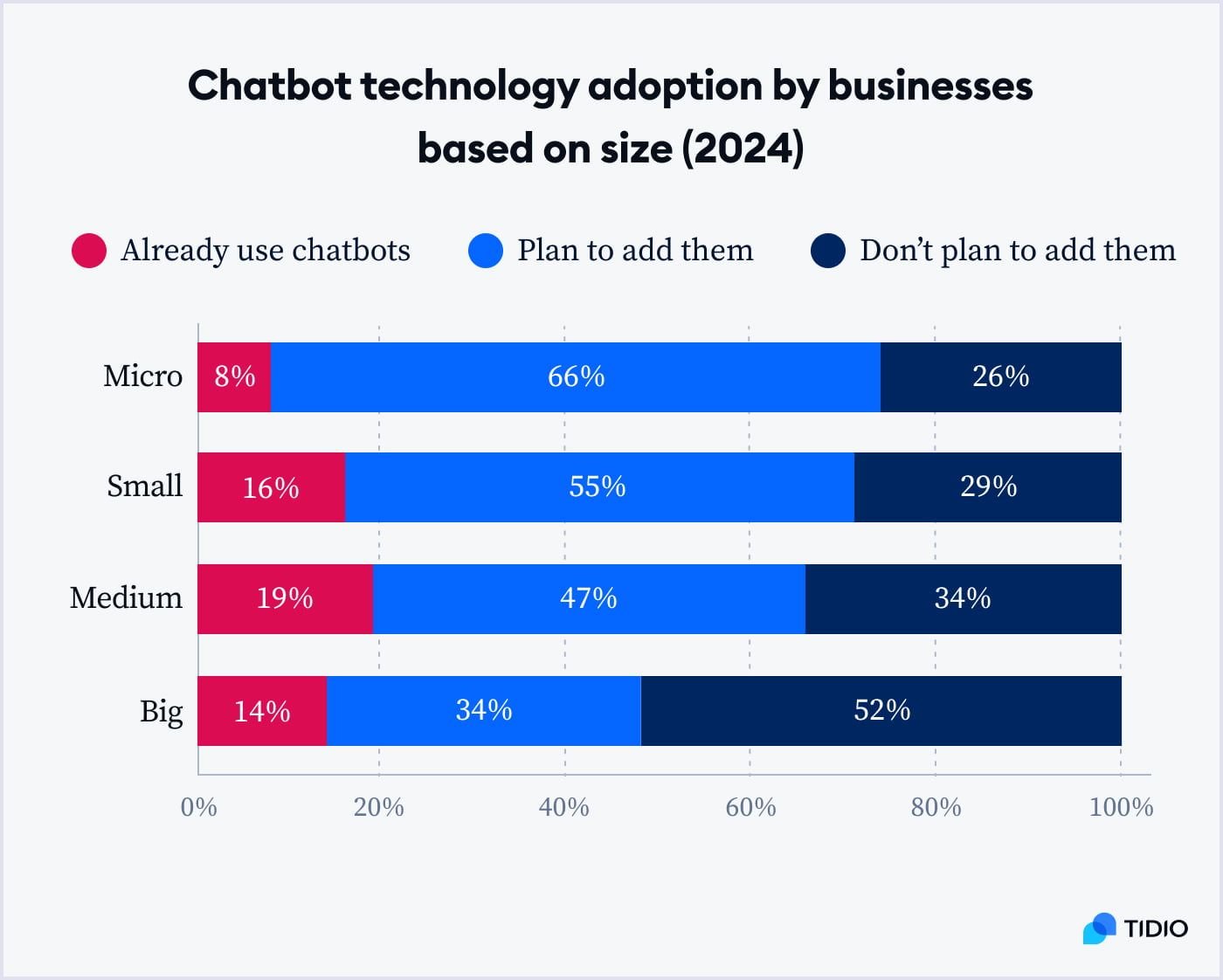
Source: Tidio
To sum up, there are two determining factors you should know about before adopting an AI. Firstly, the ecommerce industry is steadily growing. Secondly, the demand for AI features is higher than ever and keeps growing. Thus, it is more than enough information to think about introducing AI to your software without hesitation.
Types of AI technology used in ecommerce
Artificial intelligence is not an all-in-one solution. It has four main branches, each with a different focus.
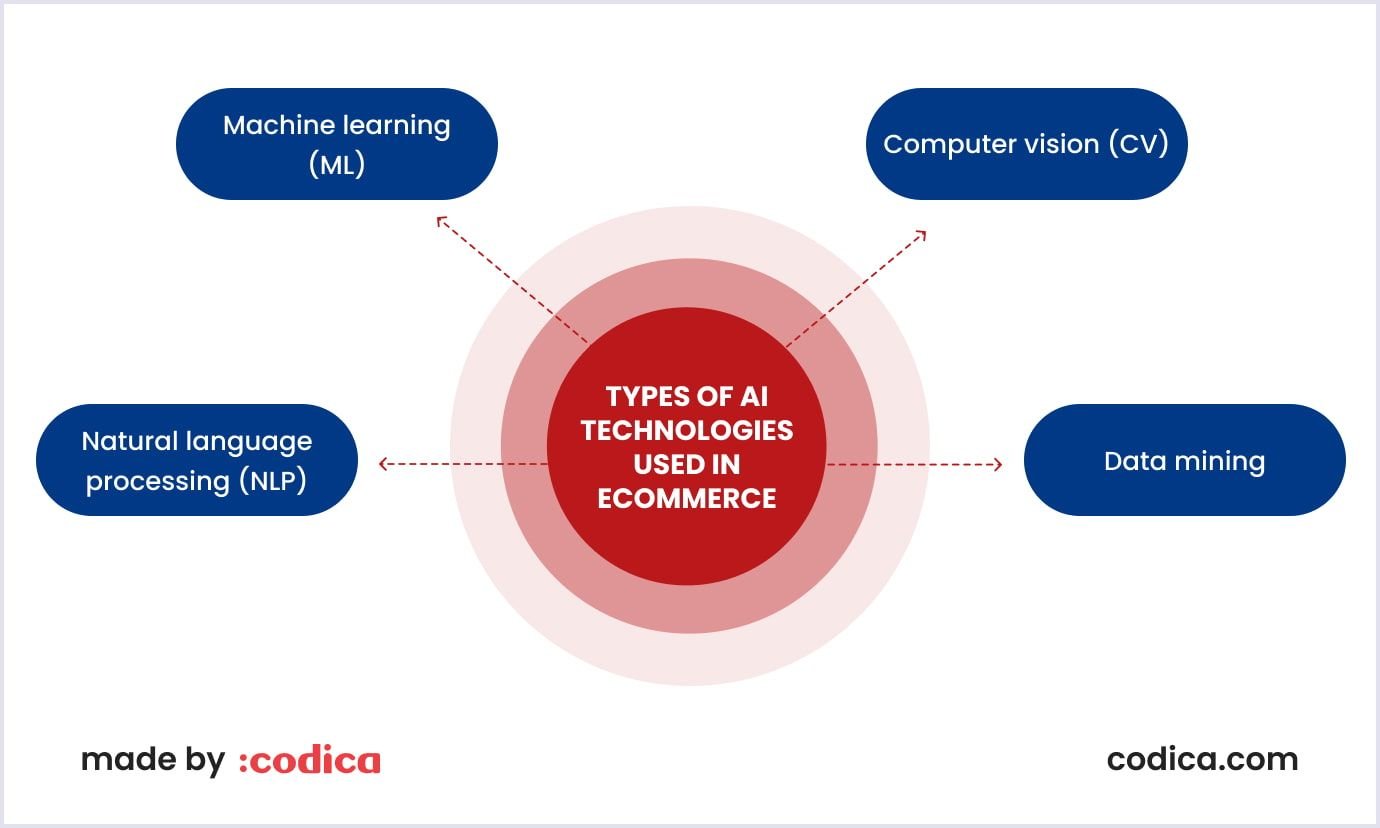
- Machine learning (ML). It is about training computers to learn from data and make predictions or decisions without being explicitly programmed. ML involves using statistical techniques and algorithms. Some advanced ML techniques, like deep learning models such as transformers and large language models (LLMs) like OpenAI's ChatGPT, use layered algorithms to better understand data.
- Natural language processing (NLP). It aims to empower computers to focus on understanding and interacting with human language in a way that's both meaningful and useful.
- Data mining. It is the practice of uncovering valuable data to inform AI algorithms and systems, helping enhance their functionality and performance.
- Computer vision (CV). It enables computers to see and comprehend visual content from images and videos.
Use cases
The ecommerce market offers much space to experiment with different AI technologies. Moreover, many stable ones are proven to be highly effective. Let’s take a closer look at a few aspects of ecommerce that can be improved by AI.
1. Chatbots and virtual assistants
Nowadays, it’s pretty common to see chatbots and virtual assistants in online stores, websites, etc. They are good at simplifying sorting, replying, and other routine tasks. They assist in handling customer inquiries and streamline online shopping by offering helpful tips.
These AI-driven tools utilize technologies like NLP and, more recently, generative AI to comprehend and respond to customer requests.
Here are several ways AI-powered chatbots and assistants can help your business.
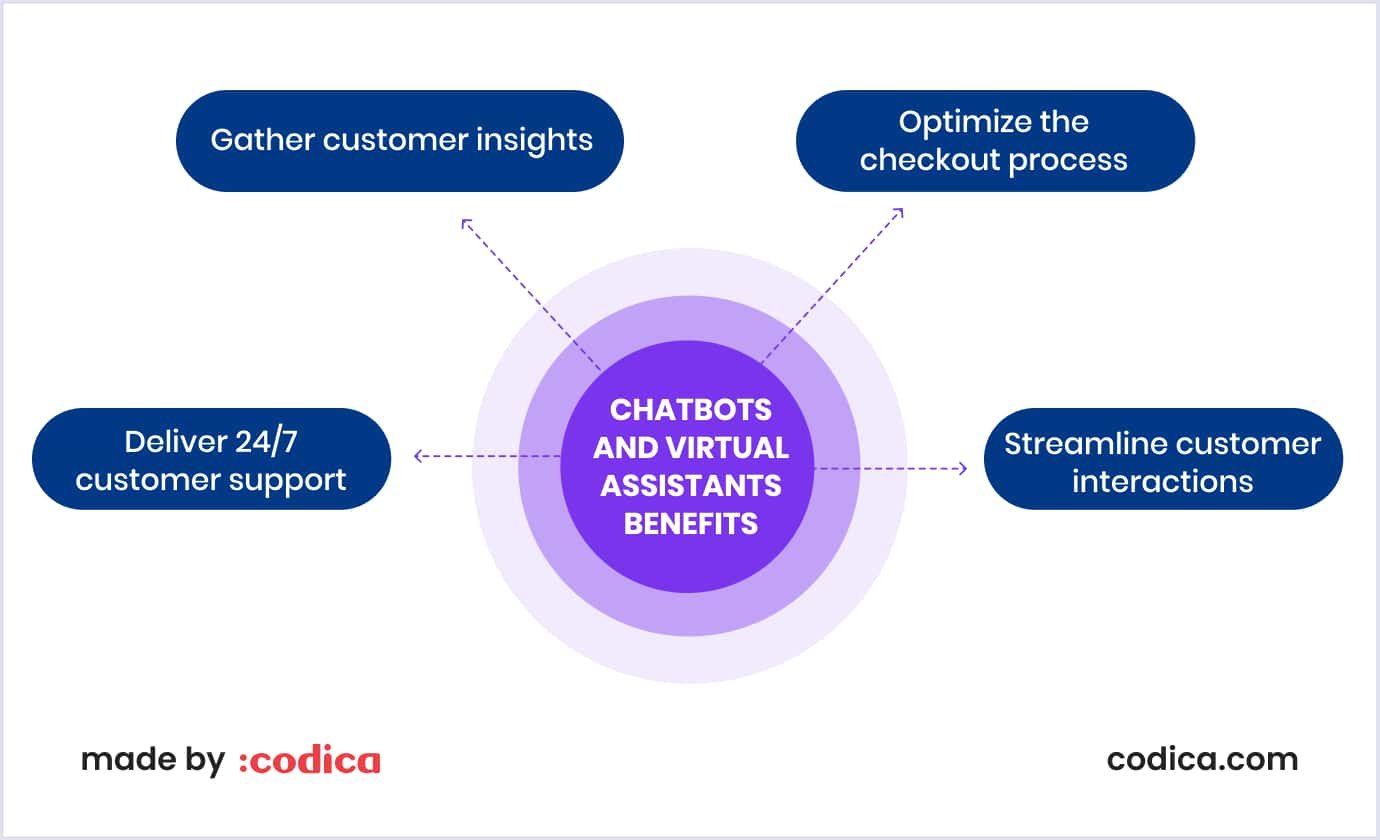
- Deliver round-the-clock customer support. Сhatbots and virtual assistants aren’t limited in time and resources. They can ensure rapid 24/7 responses, freeing live support agents to focus on more complex customer service issues.
- Gather valuable customer insights. Chatbots can gather customer information, like size preferences and the reasons for inquiries. You can later use this data to improve product development and enhance customer service strategies. Additionally, they can help streamline the checkout process for a smoother shopping experience.
- Optimize the checkout process. Online businesses can seamlessly integrate chatbots into the checkout page, enabling customers to inquire about product details, item quantities, and shipping information without leaving their shopping cart.
- Streamline customer interactions. Chatbots and virtual assistants efficiently manage basic transactions, order processing, and personalized offers across various point-of-sale (POS) channels, whether it's a physical store, online platform, or a mobile app, making it easier to handle high request volumes.

2. Generative AI
After becoming one of the most popular tools on the Internet, generative AI quickly made its way into ecommerce. Gen AI can create different media according to what users prompt, be it texts, videos, pictures, infographics, and more.
In the realm of ecommerce, marketing is important and is a primary aspect that utilizes generative AI capabilities.
For example, you can customize your newsletters’ visuals with generative AI and personalize them for different types of customers. AI can also help to create other marketing materials like social media posts, useful infographics, statistical overviews, etc.
You may also like: ChatGPT API: Tutorial Guide
3. Security and suspicious activity detection
Working with vast arrays of data, AI can assist in fraud detection and prevention by analyzing it. In layman’s terms, it can detect suspicious activities while monitoring transactions in real time.
Suspicious activities, in general, mean unusual transactions, such as high-value transfers, multiple transactions within a short time frame, and more. After detecting them, AI can flag them for further investigation.
Additionally, fraud activities also involve accounts and their creation. If using your platform requires creating a unique account per person, make sure there are no breaches that allow people to create multiple accounts and exploit them.
Lastly, ML, or machine learning, is also helpful in this regard. Machine learning models can be harnessed to create user profiles by analyzing behavioral data, encompassing browsing patterns, transaction records, and device history. These profiles can then be employed to compare present consumer actions with historical data to pinpoint potentially fraudulent behavior.
For instance, if a user makes an unusually large purchase from an unfamiliar location, the machine learning model can raise a fraud alert if it contradicts their established data profile.
4. Inventory management
As your venture grows, inventory management can get wearisome, and even the slightest mistakes can lead to long-term consequences and detriments. AI and machine learning models can help you manage inventory by analyzing historical sales data and predicting future demand.
For example, today, stores obtain real-time data about the stock using RFID (radio-frequency identification) tags and sensors to detect them. Then, data inputs are subsequently analyzed by specialized software, swiftly producing real-time outcomes pertaining to various aspects such as stock management, transactions, inventory status, or the individual purchase history of customers.
So, how can AI improve the inventory management routine? It can enhance inventory management through two main applications:
Inventory allocation. This process involves distributing available stock across various locations, channels, and products to optimize customer satisfaction and profitability. AI employs optimization algorithms to find the ideal allocation that:
- Minimizes costs (e.g., holding, ordering, transportation, and stockout costs);
- Maximizes benefits (e.g., revenue, service level, and customer loyalty).
Furthermore, AI considers various constraints such as capacity, lead time, demand fluctuations, and inventory policies. It provides valuable recommendations and solutions to help businesses streamline their inventory allocation processes.
Demand forecasting. With machine learning algorithms, AI analyzes tons of data to generate precise and timely demand forecasts, assisting businesses in planning their inventory levels and replenishment strategies. AI can dynamically adjust these forecasts based on real-time data and feedback, accommodating uncertainties and fluctuations in demand.
5. Personalized product recommendations
Crucial for numerous online stores and marketplaces, personalized search recommendations stand out as a prime example of AI in action. Personalized product recommendations rely on information from a customer's past behavior and actions to suggest products they're likely to be interested in.
6. Customer behavior analysis
In ecommerce, grasping your customers' behavior and preferences is vital for successful sales. With the help of AI, businesses can gain a deeper understanding of their customers and discover emerging trends. AI and ML can make good use of the extensive data they collect from your platform.
For example, they can help you identify and decrease customer churn by predicting when customers might be close to leaving your platform. Fortunately, ecommerce platforms have many indicators that can be helpful in such analysis. The most popular ones are:
- Bounce rates;
- Percentage of abandoned carts;
- Browse abandonment.
After gathering the data and identifying bottlenecks, you can come up with various solutions. For instance, you can create pop-up reminders to check out the goods people added to the cart, automate purchase completion emails, or even provide loyalty discounts.
7. Dynamic pricing
With AI-powered dynamic pricing, businesses can adjust prices and product offerings based on global supply and demand, competition, and users’ behavior in real time.
AI provides businesses with the ability to spot the best discount opportunities and decide on the minimum discount required to boost successful sales.
AI grants multichannel retailers increased versatility in structuring their pricing. Through AI, retailers can intelligently adjust prices across various point-of-sale (POS) channels, tailoring them to observed demand patterns.
For instance, if a retailer sells products both on their website and through Amazon, they can judiciously offer discounts on Amazon when they observe a significant surge in purchasing activity from that specific channel.
Top AI tools for ecommerce
As you see, AI use cases in ecommerce are rich, and adding artificial intelligence can definitely improve different parts of your business. Many of them are fairly easy to understand, so there are usually no issues with how to use AI in ecommerce. Let’s overview several prominent examples.
1. Zapier’s AI Chatbot
Moving to AI chatbot for ecommerce, the IT market has a myriad of solutions to offer. Zapier’s AI Chatbot is one such example.
It utilizes the power of GPT and allows you to create custom chatbots. You can start using it quickly, as the platform lets you name the chatbot, teach it how to respond, and connect the chatbot to the knowledge base so it can utilize the information and generate accurate responses.
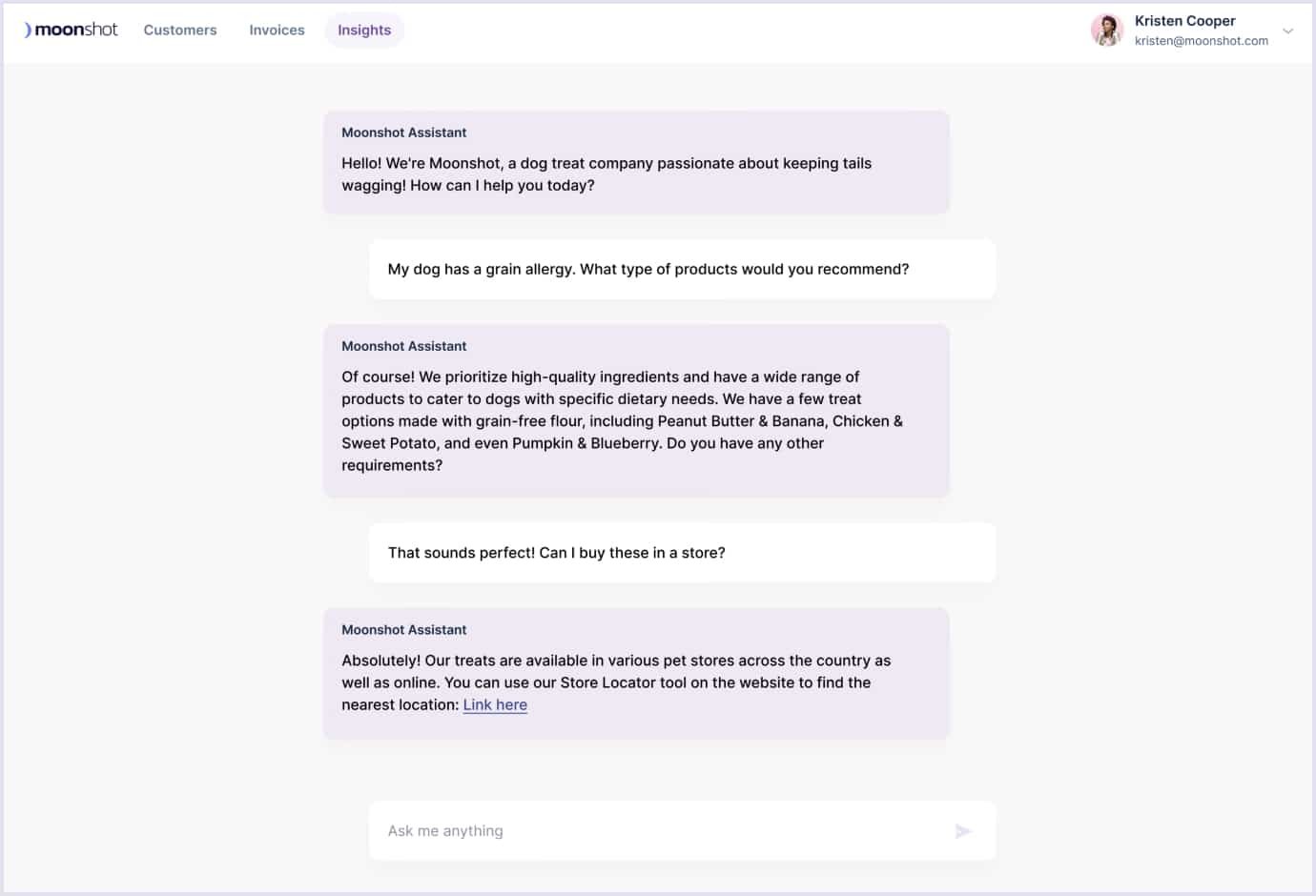
Source: Zapier
2. Maverick
Apart from usual generative AI tools like ChatGPT and Midjourney, there are dozens of other solutions that utilize AI and enhance the marketing routine. Maverick, in this regard, greatly simplifies the video aspect of marketing.
Maverick utilizes real videos, changes, and alters them to help ecommerce ventures have personalized interactions with their clientele. Additionally, according to their website, Maverick is fairly easy to use, and the entire setup can be done in five steps:
1. Record a video. It has to be a base video addressed to your customers.
2. Record a script. Read a short 15-minute text provided by the tool so that the AI can analyze your voice and use it in further videos.
3. Integrate the tool with your CRM. This way, Maverick will help you set up notifications from your CRM to automatically tell the tool once you want to send a personalized video.
4. Wait for videos to be generated. After some time, Maverick processes videos, creates branded landing pages to host the videos and sets up email delivery from your domain.
5. Launch your campaigns. Once the videos are processed, Maverick will send you samples to review. Once you approve the work, they will start the campaign.

3. ComplyAdvantage
As mentioned, there are various AI-based tools to withstand fraud and other suspicious activities. ComplyAdvantage is a solid example of such a tool.
ComplyAdvantage is able to analyze and detect many different fraud scenarios. For instance, it can detect ATO or account takeover fraud, email compromise fraud, synthetic identity fraud, and more. Besides, it can not only flag suspicious activity but also explain its choice, providing detailed behavioral analysis and other information.

Source: ComplyAdvantage
4. Inventoro
Managing inventory can be tedious if handled poorly. Thus, adding AI integration simplifies this routine while providing much more benefits. Consider Inventoro, an AI-driven replenishment, optimization, and industry-standard inventory management.
Inventoro provides several handy services for inventory management.
First off, they provide sales forecasting based on your sales history. Forecasting can help you optimize the replenishment process, meaning that it will help tell you the right quantity to order and the ideal timing, aligning supply with demand while avoiding over-ordering.
Additionally, this AI tool helps you optimize the inventory. For instance, you can segment your stock with its help and see which items generate more income and which ones are less popular.
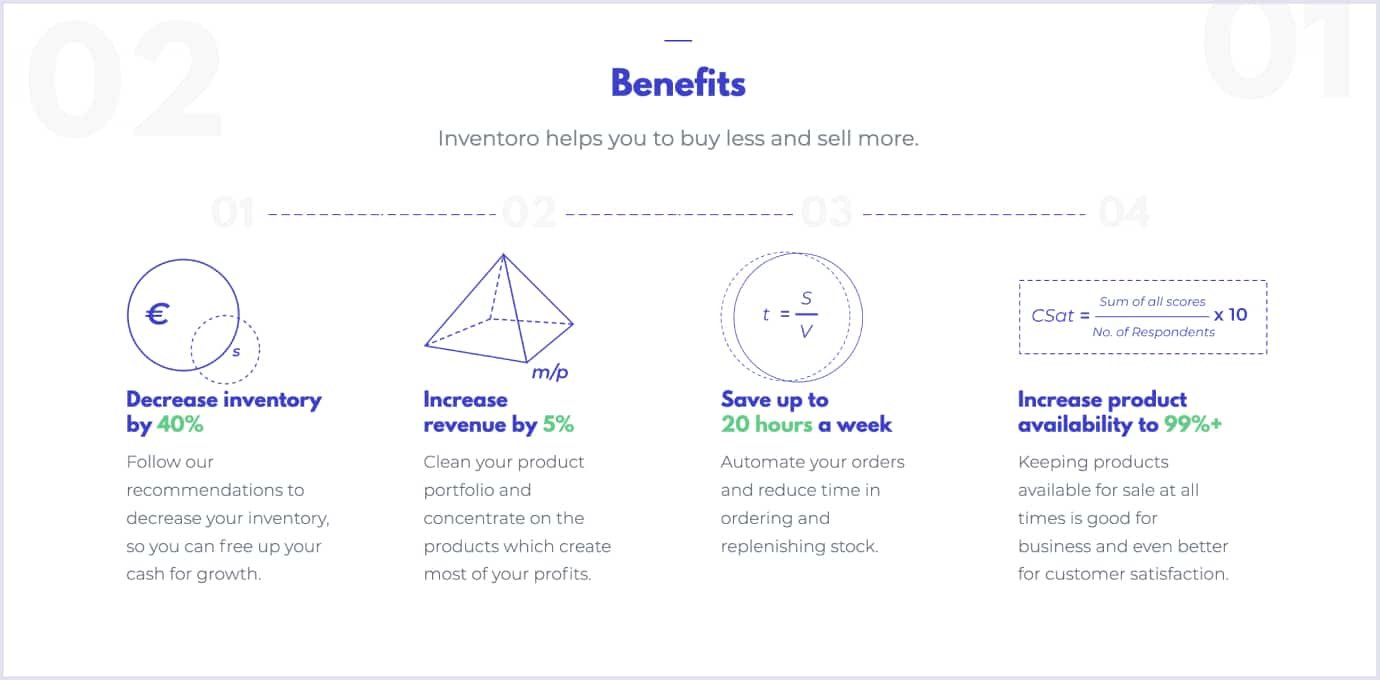
Source: Inventoro
5. Vertex AI Search by Google
To deliver an exceptional AI system for personalized product recommendations, Google came up with Vertex AI Search, formerly known as Recommendations AI.
Vertex AI Search aims to help businesses deliver highly personalized product recommendations at scale. Traditionally, their documentation page describes everything there is to know about this technology.
Alternatively, feel free to watch a short video where the Google team explains how their creation works and how your business can benefit from it.
After all, product recommendations are a very powerful thing, and each of us remembers using them at least once.
Many leading companies use AI-powered features like “People also purchased” or “Customers also viewed” to suggest complementary products based on size, color, shape, fabric, brand, and other aspects.
6. Aidaptive
Understanding your customers and delivering an exceptional shopping experience is a must in ecommerce. Aidaptive is a great AI-powered tool that can assist you with it.
This tool aims to provide your users with an individual and personalized shopping experience and increase essential metrics like conversion rates, average order value (AOV), and others.
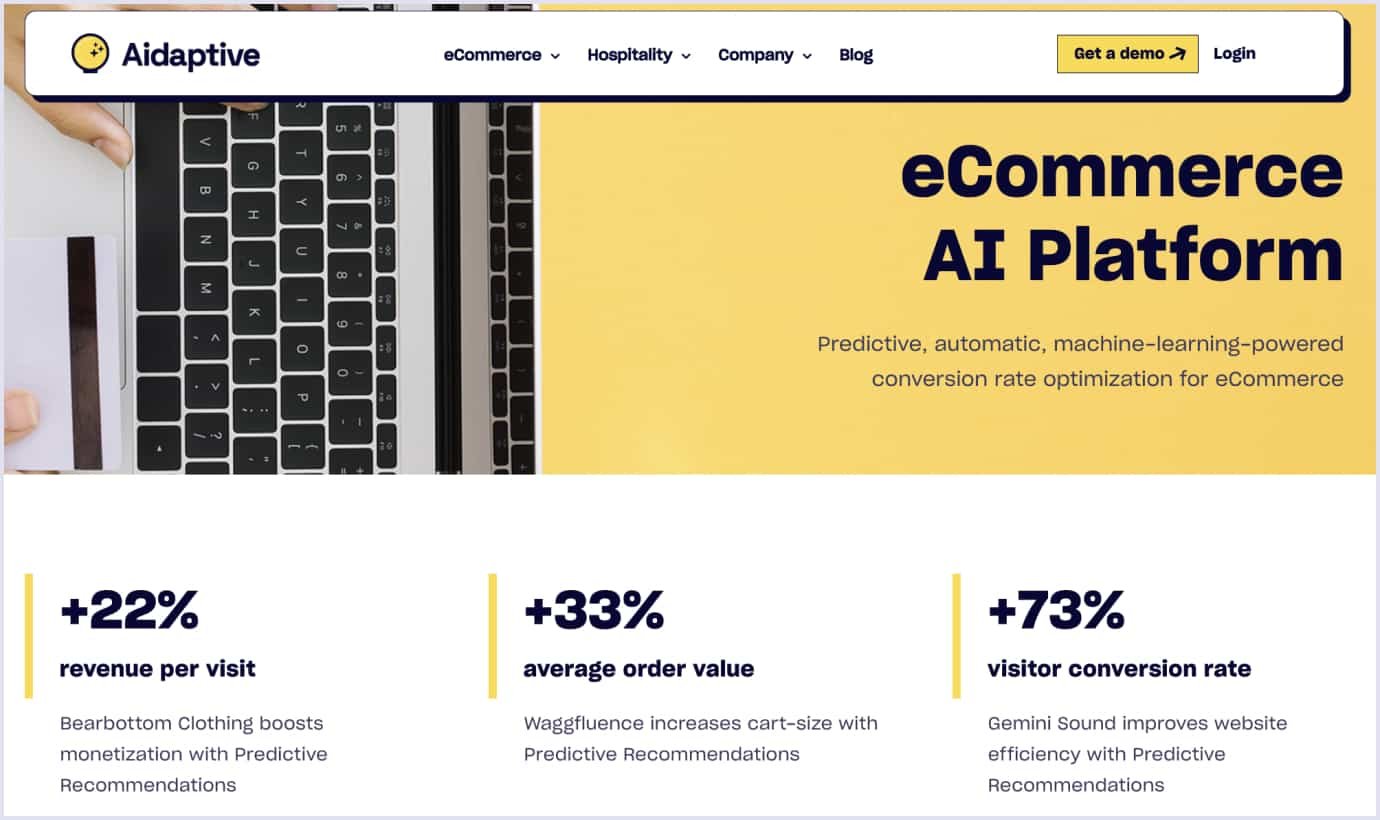
Source: Aidaptive
Essentially, this platform runs in the background of your ecommerce venture and delivers automated product recommendations to users, simplifies site search, and more.
Aidaptive gathers sales information on your store and analyzes it 24/7. Then, it prioritizes certain products over others to maximize profitability and show customers goods they will most likely want to buy.
Lastly, the integration of Aidaptive tool is seamless and handled by the team. It doesn’t slow down your website and can learn from whatever data is available. Moreover, it can also align many different solutions you may already be using, such as Mailchimp for email marketing or Triple Whale for data analysis.
Benefits of using AI and ML in ecommerce
As the ecommerce sector gradually grows, it adopts numerous new technologies to stay afloat and satisfy customers. Thus, the benefits of AI in ecommerce are hard to underestimate.
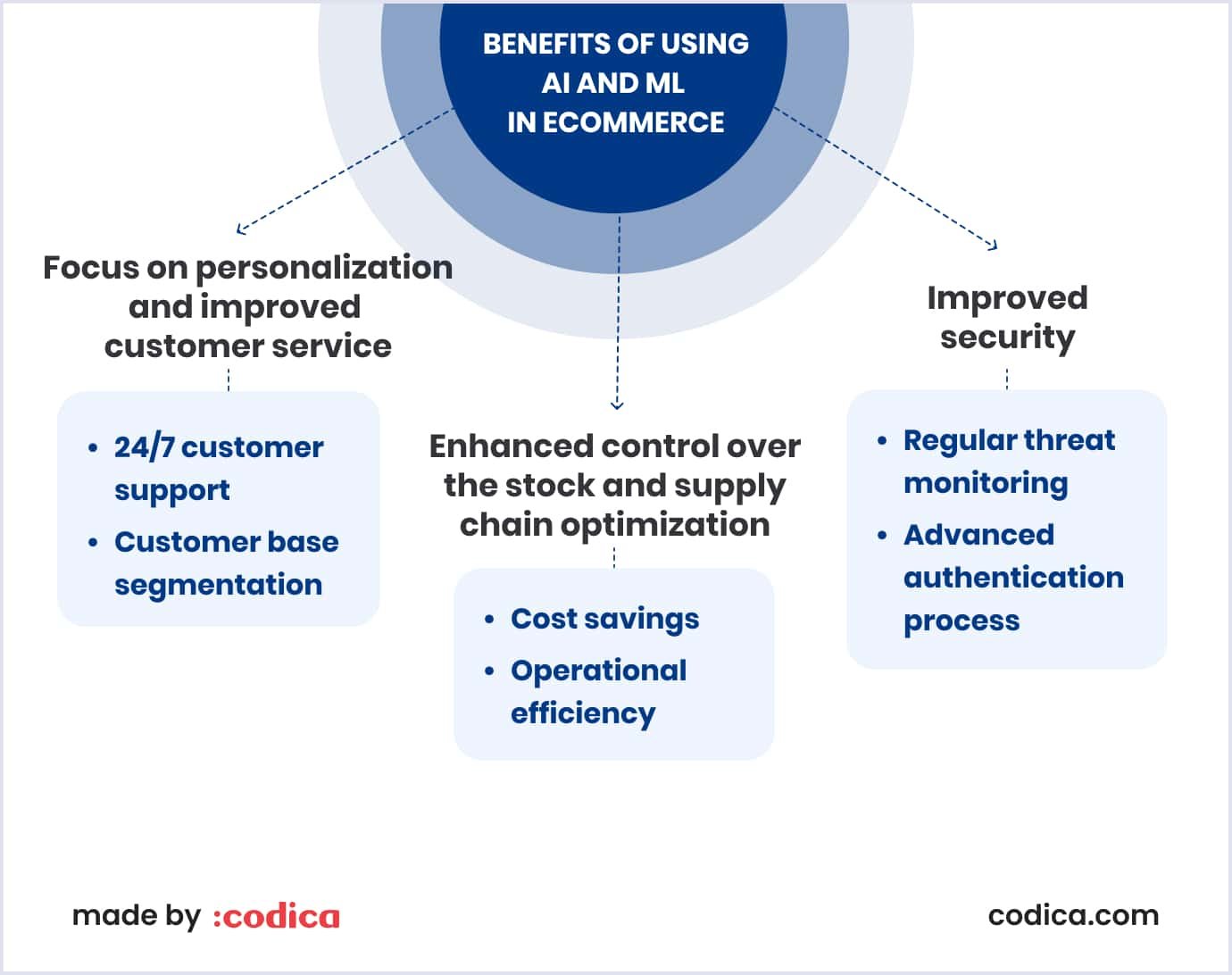
Focus on personalization and improved customer service
AI can analyze lots of customer data to provide personalized product recommendations, content, and shopping experiences. This enhances customer engagement and increases sales.
Moreover, by introducing chatbots and virtual assistants powered by AI, you can not only count on a superior shopping experience but also provide 24/7 assistance to users. This will help resolve their issues, answer common inquiries, and provide quick responses.
AI allows you to divide your customer base into segments and create tailored marketing campaigns for specific groups. This not only makes marketing more effective but also forges a stronger bond between customers and your brand.

Enhanced control over the stock and supply chain optimization
AI can effectively identify trends and rising interests of your customers by using historical data, forecasting, and seasonality. This way, you can optimize the stock and supply chain processes, reducing costs and improving efficiency in logistics.
As a result, you get:
- Improved customer satisfaction. Customers experience fewer stockouts and receive their orders promptly. This leads to increased customer satisfaction and repeat business.
- Cost savings. Efficient supply chain management and reduced inventory holding costs contribute to improved profitability for businesses.
- Operational efficiency. AI streamlines many processes, reducing manual effort and the potential for errors. This allows businesses to allocate resources more strategically.
- Scalability. With rapid growth of ecommerce AI and ML systems easily adapt to changing needs, providing flexibility and scalability in inventory management and supply chain operations.
Improved security
As mentioned previously, using AI for security purposes is another practical, forward-thinking example. AI can detect and prevent fraudulent transactions by analyzing patterns and anomalies, enhancing security for both businesses and customers. For instance, it can:
- Enhance user authentication and authorization processes with multi-layered security;
- Predict potential security threats by monitoring and analyzing user behavior in real time;
- Identify unusual activities that may indicate a security breach and take immediate preventive actions;
- Provide AI-driven encryption techniques.
All these measures ensure flawless user experience and protection of sensitive customer data, including payment information and personal details. This protects customer privacy and complies with data protection regulations, fostering trust among shoppers.
Read also: Web Application Security: The Ultimate Guide
Codica's expertise
Imagining which AI tools you want to add to your ecommerce business is all fun and games, but when it comes to actual implementation, various obstacles may arise on your way.
In Codica, we saw numerous scenarios leading to serious detriments. So, by choosing our services, you can avoid unnecessary risks, save plenty of resources, and deliver your product to market fast.
In this regard, we have two options to offer.
Product discovery: laying the foundation
Many of our clients start with product discovery, as it is a crucial first step in custom software development. This phase involves in-depth research and analysis to shape a solution that aligns perfectly with your business needs. As a result, product discovery helps you mitigate serious risks, save costs, and make more thoughtful decisions regarding the future of your product.
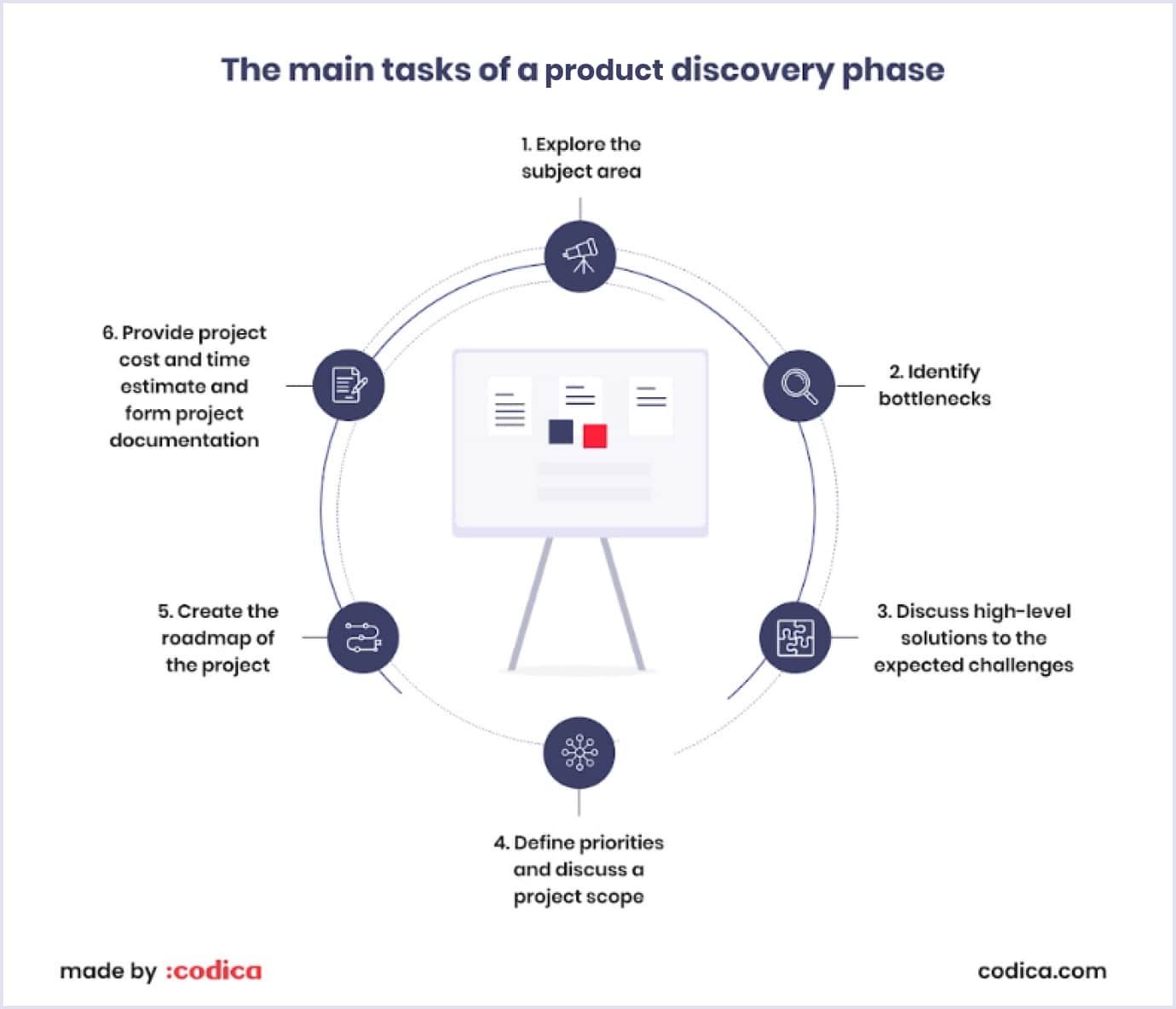
One of the primary goals we set is to explore. Thus, our team carefully studies the subject area and analyzes the business idea you bring. After that, we deep dive into the problem our client seeks to solve. We do a lot of work putting together expectations and their implementation while identifying potential challenges, priorities, and bottlenecks.
Long story short, by the end of this extensive process, we deliver a lot. For example, our clients are presented with clear feature sets, prototypes, and meticulous documentation. Once you are all set with the product discovery, we move to the second phase.
Ecommerce marketplace development: bringing visions to life
Throughout the years, we have shipped more than 50 marketplaces varying in niche and complexity. So, at this point, your vision we clearly outlined previously takes shape.
Once we figure out the scope of work, our team divides the development process into 5 manageable steps.

- Consulting services. We conduct a thorough analysis of the needs and potential issues faced by average customers, aligning them with how our marketplace can offer solutions.
- UI/UX design services. Our UI/UX experts stay updated on the latest design trends to craft a modern and user-friendly marketplace.
- Ecommerce marketplace development. We tailor your marketplace to meet its unique requirements, covering front-end and back-end development, integrating databases and payment gateways, and providing customization.
- QA testing services. Our QA specialists employ diverse testing methods to ensure your business idea operates smoothly and without issues.
- Support and maintenance. We offer regular updates, issue resolution, and optimizations to maintain the security, stability, and up-to-date status of your marketplace.
Now, let’s talk about features. Ecommerce platforms tend to be huge and complex, featuring tons of functionality. Fortunately, our ecommerce marketplace development service not only implies the creation of a raw product but also includes enhancing the platform with everything needed.
Apart from absolute must-have features like push notifications, a search system, filtering options, or shipping, we can deliver much more.
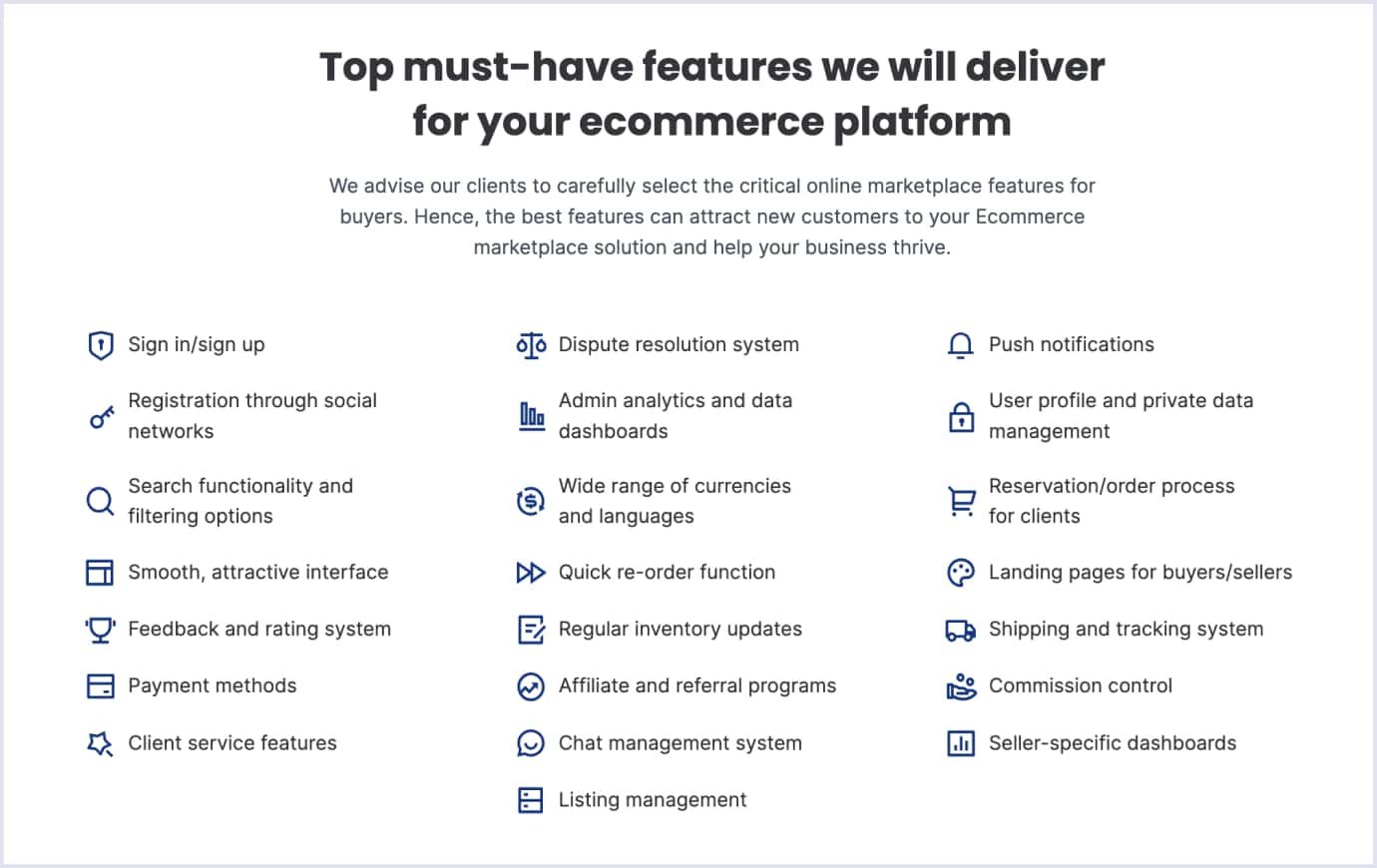
For instance, we tend to add advanced data dashboards that allow you to track many metrics and the overall performance of your platform. AI integrations, which we cover today, are also in our capabilities. Depending on the specifications of artificial intelligence, we can suggest several options present on the market, consult you, and integrate them into your software along with other handy features.
Bottom line
AI's integration into ecommerce is not something new and innovative. To some extent, it is a necessity as customers’ expectations regularly rise. Luckily, the market has plenty of solutions to offer, and it is up to you to choose wisely.
Alternatively, you always refer to our product discovery services, where we analyze, research, and advise on seamlessly integrating AI into your solution. Simply put, AI reshapes how businesses engage with customers and operate in the digital marketplace, and you must ensure your business stays afloat on the market.
In this regard, feel free to contact us, as our professional team has a superior understanding of how everything should be done. Additionally, always stay informed about what’s happening in the market. You can do it by reading the latest news or by checking out our blog, where we regularly highlight everything people should know about technology, management, design, and more.

